Semiconducting Single Atom Chains: A New Research Frontier

The elements selenium and tellurium naturally crystallize as bundles of parallel atom chains (top). This research aims to isolate just one of these semiconducting atom chains (bottom) for use in electronic and optical circuits.
In the spirit of interdisciplinary research championed, the Department of Physics in the J. William Fulbright College of Arts and Sciences and Department of Electrical Engineering in the College of Engineering have made progress on an exciting new idea that developed because of different points of view from different disciplines. The discovery of graphene, a single sheet of carbon atoms, created a wave of exciting research in atomically thin two-dimensional materials.
Inspired by graphene, researchers at the University of Arkansas are at the frontier of a new research direction to create atomically narrow one-dimensional wires, called "single atom chains." If successful, this work funded by a $60k Short-Term Innovative Research award from the Army Research Office could potentially revolutionize electronics.
Hugh Churchill, assistant professor of physics, will collaborate with Shui-Qing "Fisher" Yu, associate professor of electrical engineering, and Gregory Salamo, professor in physics, for the project. The team has been pursuing this new direction for two years already. Recently, associate professor Salvador Barraza-Lopez and assistant professor Jin Hu, both from the Department of Physics, joined the team to model and fabricate this new group of materials.
In the past, efforts to create nano-electronic components to surpass traditional silicon circuits have focused on one-dimensional nanotubes and nanowires. However, these earlier components either suffer performance degradation at the smallest sizes or possess random and difficult to control physical properties.
Earlier this year, the research team published an article titled "Toward Single Atom Chains with Exfoliated Tellurium" in the journal Nanoscale Research Letters, showing that nanoscale structures can be fabricated by exfoliating tellurium (Te) into ultra-thin flakes and nanowires [1]. This work received an early boost from a U of A Connor Faculty Fellowship that allowed the purchase of tellurium crystals for exfoliation.
This new research initiative aims to apply the previous findings to the creation of one-dimensional structures that can be fabricated using tellurium (Te). These materials not only have the capability of being exfoliated into ultra-thin nanowires, but also possess superior electrical, optical, mechanical, and chemical properties. Some of these properties have been described in theoretical research led by Barraza-Lopez that has been submitted for publication [2].
This new structure is expected to push traditional electronics to the atomic endpoint of scaling, while opening up a new field of quantum circuits. In addition to electronics, these structures may also improve technological capabilities in sensing and communication. Given the technological promise of these structures, the researchers submitted a provisional application for a patent last spring and the university has already committed to a full patent application.
"We are very excited about this research direction and hope to leverage this early investment from the Army to build a larger atom-chain research initiative across several departments on campus," said Churchill.
"We are very fortunate to have complementary expertise in material science, transport, optics, theoretical modeling, and electronic devices to build an interdisciplinary team supported by the state-of-art facility at the Nano Institute to tackle these challenging problems," added Yu.
Contacts
Hugh Churchill, assistant professor
Department of Physics
479-575-7235, churchill@uark.edu